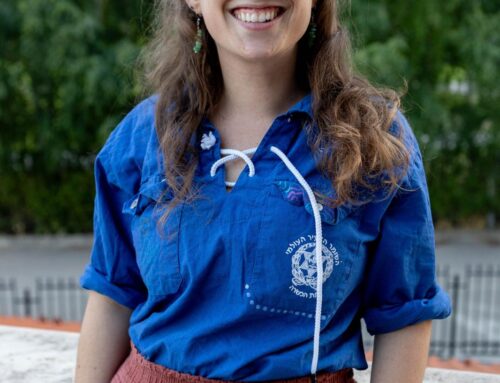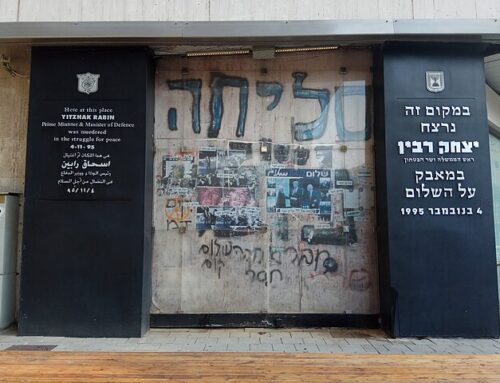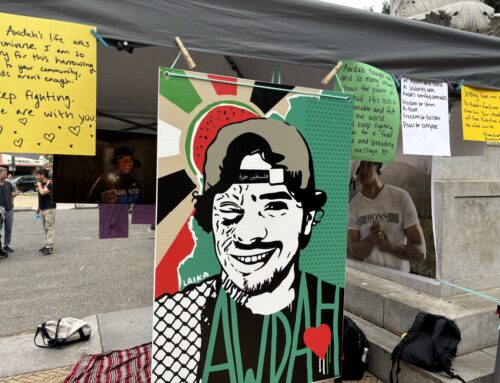Meretz and the Question of Jewish-Arab Political Partnership
by Ron Skolnik
In the run-up to Israel’s March 2021 elections, the veteran Meretz party has broken new ground: It is offering a slate of candidates that features the highest level of Jewish-Arab integration ever seen in a party that defines itself as Zionist. Three of the party’s first ten (nine to be exact) candidates, and two of its first five, are Arab. If recent polling results hold true (five to seven seats), this means that about 30 to 40 percent of the party’s new Knesset faction will be made up of Palestinian-Arab citizens of Israel.
Compare the current slate to 1992, the first time the party ran, when, of the twelve Knesset members it earned, only one (Walid Sadik in the ninth slot) was a member of Israel’s Arab community. This was no aberration: Meretz’s 1996 lineup featured the same level of Arab representation and its 1999 list amounted to a slight demotion, with MK Hussniya Jabara placed one spot further down, at ten. When the party dropped from ten to six seats in 2003, Jabara lost her Knesset seat, and for the first time since its founding, Meretz elected no Arab Knesset members at all to its parliamentary faction. This absence would continue for a decade, until MK Esawi Frej cracked the top five in 2013. But, even then, Frej was Meretz’s sole Arab candidate in its top twenty.
Meretz’s new election list is, therefore, a major step forward. And yet … what does it say when, three decades into the party’s existence, the prominence of Arab candidates represents a bold innovation for the left-most Zionist political force in Israel?
Meretz’s history, it must be noted, is not an outlier in the Israeli system. The minimal Arab representation in the party before now (with the short-lived exception of the April 2019 elections) is entirely consistent with the tradition of de facto segregation in Israel’s politics. Aside from a few efforts at true political integration – the first two decades of the Hadash party and the mid-1980s Progressive List for Peace come to mind, along with the current minuscule Da’am party – Israeli parties orient themselves either toward Jewish or toward Arab constituents, and their electoral slates are populated accordingly.
Several party lists are purely Jewish or purely Arab, such as the ultra-orthodox Shas and United Torah Judaism, the rightwing/national-Orthodox Yamina, or the United Arab List, which is considering an independent run this year apart from the Joint List composite slate. Most major parties (even Likud) are not completely homogeneous in makeup, however, and include at least one (sometimes token) candidate from the “other” community. Nonetheless, these parties (including, on the left, Meretz as well as Hadash in recent decades) are composed predominantly by either Jewish or Arab candidates and draw their vote almost entirely from either Jewish or Arab constituencies. Meretz’s new list is therefore a welcome signal of change.
This de facto segregation in Israeli politics should really come as no surprise, given the degree of de facto segregation in Israeli society overall. Jewish and Arab children, for example, grow up separately and attend separate schools. A 2014 Taub Center study found that only “6 percent of all the pupils in Israel … attend schools in which some encounter between [Arab and Jewish] pupils takes place.” And Jews and Arabs live apart as well. Only 10 to 15 percent of Arab citizens live alongside Jews in what are called “mixed cities” (the term itself is remarkable inasmuch as it connotes that “mixing” is an exception to the norm); the rest reside in about 140 strictly Arab localities. Even in the “mixed cities,” such as Haifa, Jews and Arabs are largely segregated by neighborhood. Residential segregation, in turn, has an adverse effect on Arab integration in the labor market and the dominant Jewish segment of the economy.
The reality of segregation of course seeps into both communities’ attitudes, though more powerfully on the Jewish side. In 2018, the residents of Afula, led by a former mayor, launched a campaign to prevent residential sales to Arab citizens in order to keep it from becoming a “mixed city.” In 2016, rightwing Knesset Member Bezalel Smotrich, who would go on to become a Cabinet Minister in the Netanyahu government, called for segregation in hospitals.
Explicitly segregationist attitudes are sometimes endorsed by a majority of Jewish citizens. A 2019 Israel Democracy Institute (IDI) study found that 59 percent of Jews (compared to 44 percent of Arabs) support separate Jewish and Arab schools, while a whopping 84 percent of Jews said they would not marry an Arab or allow their children to do so. A nearly as large 77 percent of Arab respondents shared this sentiment regarding Jews.
Even when segregation doesn’t enjoy majority support, it is often endorsed by a significant minority. In one study, 30 percent of Jewish respondents (vs. 21 percent of Arab respondents) agreed that they should be allowed to choose an all-Jewish (or all-Arab) hospital room. According to the IDI survey, 35 percent of Jews said they are unwilling to have an Arab friend, while 38 percent are unwilling to have an Arab neighbor. (Among Arabs, the numbers were 14 percent and 11 percent, respectively, regarding a Jewish friend or neighbor.)
The causation behind widespread segregation in Israel is beyond the scope of this article. It should be noted, however, that the Israeli NGO Adalah argues that this reality is the product of more than just voluntary mutual avoidance, and involves deliberate State policy. Adalah points, in particular, to the law that allows “admissions committees” to filter out applicants to small Jewish communities based on their “social suitability.” The NGO also notes the work of quasi-governmental organizations like the Jewish National Fund, which is mandated to operate on behalf of Jewish citizens alone.
Regardless of the causes, the segregation prevalent in society also seems to reinforce the thinking, even among progressive Jewish Israelis, that Israel somehow belongs more to its Jewish, than to its Arab, citizens. Take, for example, a recent interview given by Meretz MK Yair Golan. While endorsing the concept of “Jewish-Arab partnership,” Golan demonstrates that a subliminal “us and them” mentality remains strong, even on the left, as he appears to suggest that such partnership involves not a rejection in principle of greater Jewish “ownership” over the country, but Jewish citizens nobly exercising their proprietorship to welcome in Arab citizens. Here’s Golan in December 2020:
“Jewish-Arab partnership is part of Zionism. It’s written in the Declaration of Independence that we” – i.e. representatives of the Jewish community – “extend our hand in peace to the Arab public to take part in the upbuilding of the land. Therefore, every Zionist party needs to accept into its ranks representatives of the Arab community.”
It’s not that Golan’s brand of left-Zionism is anti-equality. On the contrary: Golan has demanded the repeal of Israel’s “Nationality Basic Law,” which enshrined the principle of greater Jewish privilege in statute; he described that legislation as “a finger in the eye,” designed to make clear the second-class nature of Arab citizens. Indeed, Golan’s de facto entry into politics, while still Deputy Chief of Staff, was a speech he delivered on Holocaust Remembrance Day in which he drew parallels between the “horrific processes in Europe – particularly Germany – 70, 80, and 90 years ago” and trends in 2016 Israel. And Golan was a co-sponsor of a bill to approve a “Basic Law: Equality,” which would “guarantee that every citizen of Israel is entitled to equality and freedom by virtue of their citizenship.”
Nonetheless, Golan, in his public comments, seems to echo a status quo in which Jewish and Arab Israelis for the most part grow up apart, live apart, create families apart – and perceive their relatedness to their country differently. And while Golan is anything but a racist, it’s that status quo of separateness, unfortunately, that often serves as a breeding ground for distrust, intolerance, and xenophobia. Compare Golan’s remarks above to the op-ed penned in early December by Uri Zaki, the chair of the Meretz party executive, who has been among those pushing Meretz to become a fully integrated Jewish-Arab political force:
“Meretz needs to begin to behave as an equally Jewish-Arab left party. My model is the wonderful social movement, ‘Standing Together,’ where the Jewish-Arab aspect is manifested at every level of operation: The choice of issues [to tackle], activity in Arab and Jewish communities, egalitarian publications in both languages [Hebrew and Arabic], and, of course – [joint] Jewish-Arab leadership.”
Such a call for joint Jewish-Arab leadership was made in 2019 by former Meretz MKs Esawi Frej (Arab) and Mossi Raz (Jewish). Frej and Raz proposed that Meretz institute a structure with two co-chairs, one Jewish and one Arab, and they expressed a desire to run in tandem as co-chair candidates. (They would eventually suspend their campaign and endorse the candidacy of then-chair Tamar Zandberg, who promised to advance their proposal – but Zandberg narrowly lost her position in internal elections to current chair Nitzan Horowitz.) Earlier in 2019, Meretz’s “Forum for Jewish-Arab Partnership” had issued a similar call for this co-chair structure to be required “in every official party institution,” from the chair position on down, as well as for “any official Meretz publication to be published in both Hebrew and Arabic.”
Part of what divides these two approaches, it should be noted, are considerations of electoral strategy. There is a strong belief among some in Meretz that the adoption of the full-scale Jewish-Arab model would produce a net loss of votes, driving away many Jewish voters towards more centrist party options without the benefit of an equal number of new voters to compensate. With Meretz traditionally struggling just to get past the 3.25 percent threshold needed to enter Knesset, such a shift, they argue, could be a death blow to the party. Others, however, point to the April 2019 elections, when Meretz survived davka, i.e. precisely, because of the approximately 40,000 votes it received in the Arab community. These Meretz figures point to the untapped potential among Arab voters, whose enthusiasm is often weak, contributing to depressed turnout. A fully Jewish-Arab Meretz, they say, could be attractive to those who otherwise give up on elections and stay home.
On the ideological level, the debate in Meretz, and the Zionist political left generally, calls to mind the evolving terminology employed in Israeli civil society. While those endeavoring for equality and minority rights once made use of the word “co-existence” to describe their aims and work, the term has been largely superseded by the phrase “shared society.” The latter implies a situation of co-equality; the former suggests, at worst, a model of gracious host/appreciative guest, and, at best, a sort of social détente without the presence of vital, pervasive ethnic/national interaction.
Change is slowly brewing, however, and a growing number of initiatives are seeking to create a political framework that will appeal to, and be represented by, Jews and Arabs in equal measure. One of those, the “Alliance” (Brit/Tahaluf in Hebrew and Arabic) is an initiative of Jewish and Arab public figures, including many former Members of Knesset, who are calling for a fully equal Jewish-Arab electoral slate based on the principle of civic equality. Another effort, the Joint Democracy Initiative, proposes the formation of a “joint Jewish-Arab political front” that would champion “the values of democracy and human rights, and fully equal rights for all the country’s citizens.”
Meretz is not yet the fully equal Jewish-Arab party that these groups and other figures are calling for. But its current candidate list is a major step in this direction and could be an indication of where the party will be heading over the years to come.
___

Ron Skolnik is an American-Israeli political columnist and public speaker, whose articles have appeared in a variety of publications, including Haaretz, Al-Monitor, Tikkun, and the Palestine-Israel Journal.
The views expressed are not necessarily those of Partners for Progressive Israel







As long as Meretz insists on calling itself the “Zionist left,” it’s vision of Jewish-Arab partnership will continue to be questionable.
As long as Meretz maintains its ties to the Jewish National Fund, that sells land to Jews only, its partnership with Arabs is pure tokenism.
I agree that the Keren Kayemet-Jewish National Fund is part of institutionalized discrimination. I understand, though ultimately disagree with, Meretz’s belief that it needs to stay in order to impact things from within (by at least not letting them get worse, e.g. in the West Bank). At very least, even if Meretz maintains its ties to KKL-JNF for those political reasons, there’s no reason for it not to adopt a position of support for dismantling that body, or for rewriting its articles so that it no longer serves Jews only. That being said, to argue that Meretz’s ties to KKL-JNF mean that all its other work on partnership is tokenism is hyperbole, in my opinion.